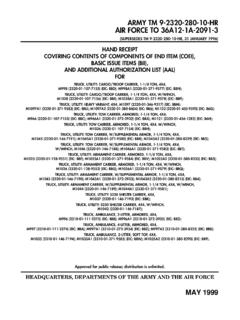Transcription of Ohio’s Alternative Energy Portfolio Standard
1 Ohio's Alternative Energy Portfolio Standard Anne Goodge The Ohio Alternative Energy Portfolio Standard (AEPS). Portfolio standards require percentages of utilities' electric generation Portfolio to be derived from renewable or cleaner technologies Ohio was about the 26th state to adopt a Portfolio Standard Ohio AEPS was created in Sub. 221, signed by Governor Strickland in May 2008. Renewable Portfolio standards / March 2009. WA: 15% by 2020* VT: (1) RE meets any increase ME: 30% by 2000. New RE: 10% by 2017. MN: 25% by 2025 in retail sales by 2012.
2 MT: 15% by 2015 (2) 20% RE & CHP by 2017 NH: by 2025. (Xcel: 30% by 2020). OR: 25% by 2025 (large utilities). ND: 10% by 2015 MI: 10% + 1,100 MW MA: 15% by 2020. 5% - 10% by 2025 (smaller utilities) by 2015* + 1% annual increase (Class I Renewables). SD: 10% by 2015 WI: Varies by utility; NY: 24% by 2013. 10% by 2015 goal RI: 16% by 2020. NV: 20% by 2015* CT: 23% by 2020. IA: 105 MW OH: 25% by 2025 . UT: 20% by 2025*. PA: 18% by 2020 . IL: 25% by 2025. CO: 20% by 2020 (IOUs) NJ: by 2021. CA: 20% by 2010 10% by 2020 (co-ops & large munis)*.
3 VA: 12% by 2022*. MO: 15% by 2021 MD: 20% by 2022. AZ: 15% by 2025 DE: 20% by 2019*. NC: by 2021 (IOUs). 10% by 2018 (co-ops & munis) DC: 20% by 2020. NM: 20% by 2020 (IOUs). 10% by 2020 (co-ops). TX: 5,880 MW by 2015. HI: 20% by 2020. 28 states have an RPS. 5 states have goals State renewable Portfolio Standard Minimum solar or customer-sited requirement State renewable Portfolio goal Solar water heating eligible * Extra credit for solar or customer-sited renewables Includes separate tier of non-renewable Alternative resources Ohio AEPS.
4 By 2025, 25% of retail electricity sold by Ohio's electric distribution utilities, AEP, DP&L, Duke Energy and First Energy , or electric service companies, must be generated from Alternative Energy sources, including both renewable and advanced Energy technology sources. AEPS Requirements A minimum of one-half of the Energy must come from renewable sources A minimum of one-half percent from solar resources At least one-half of renewable sources must be located in Ohio Out of state resources must be shown to be deliverable to Ohio Facilities placed-in service date of 1/1/98 or later Qualified Renewable Resources Solar Wind hydroelectric Geothermal Fuel cells Certain Energy storage facilities Biomass Qualified Biomass Resources Agricultural crops, tree crops.
5 Crop by- products and residues Wood and paper manufacturing waste Forestry or vegetation waste Algae Food waste, solid waste Animal waste and by-products Qualified Biogas Sources Landfill methane Anaerobic Digester gas derived from: animal waste municipal wastewater food waste vegetation waste agricultural crops and residues Advanced Energy Resources Clean coal Nuclear Fuel cells Customer Co-generation Advanced solid waste conversion Utility generation plant or demand-side management efficiency measures Impact Ohio ranks 4th among states in retail electric sales and 6th in net generation Ohio's emissions from electric generation, including, SO2, NOx and CO2, rank highly among states As the nation moves toward a lower carbon future.
6 Ohio will need to incorporate low emission alternatives in its resource Portfolio Benchmarks By end Renewable Solar of year Energy Energy 2009 Renewable 2010 12%. Solar 2011 1% 2012 10%. 2013 2% 2014 8%. 2015 2016 6%. 2017 2018 4%. 2019 2020 2%. 2021 2022 0%. 2023 09. 11. 13. 15. 17. 19. 21. 23. 20. 20. 20. 20. 20. 20. 20. 20. 2024 +. Penalties Utilities and electric service companies subject to compliance payments if annual renewable and solar benchmarks are not met $45/MWh Solar $450/MWh in 2009 and declines over time Exceptions: force majeure; 3% cost cap Renewable Energy Credits New Ohio renewable Energy credit (REC).
7 Trading market will be created in 2009. Utilities may purchase RECs to meet the renewable portion of the Standard PUCO will certify resources Established tracking systems will issue RECs and track their use RECs have a 5-year lifetime following their acquisition PUCO Rules PUCO has issued draft rules and the comment period has ended PUCO will issue final rules Rules must be approved by JCARR. For more information To follow the progress of AEPS. implementation , to the PUCO website: and click on: Biomass Energy Program Listserv Send an e-mail to : Leave subject line blank Add to the message: Subscribe ohiobiomass yourfirstname yourlastnam





